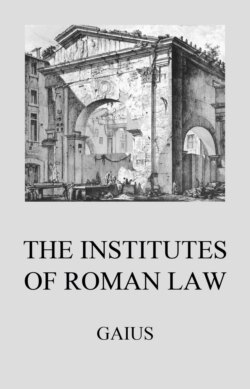Читать книгу Institutes of Roman Law - Gaius - Страница 12
На сайте Литреса книга снята с продажи.
ОглавлениеV. CONCERNING SURRENDERED ENEMIES.
§ 14. Surrendered enemies are people who have taken up arms and fought against the people of Rome and having been defeated have surrendered.
§ 15. Slaves tainted with this degree of criminality, by whatever mode they are manumitted and at whatever age, and notwithstanding the plenary dominion of their proprietor, never become citizens of Rome or Latins, but can only acquire the status of enemies who have surrendered.
§ 16. If the slave has not committed offences of so deep a dye, manumission sometimes makes him a citizen of Rome, sometimes a Latin.
§ 17. A slave in whose person these three conditions are united, thirty years of age, quiritary ownership of the manumitter, liberation by a civil and statutory mode of manumission, i. e. by the form of vindicta, by entry on the censor’s register, by testamentary disposition, becomes a citizen of Rome: a slave who fails to satisfy any one of these conditions becomes only a Latin.
§ 14. Peregrini dediticii. Cf. Livy 1, 38; Theoph. 1, 5, 3.
§ 15. Pleno jure. Cf. § 54 and 2 § 41.
§ 17. The earliest forms of manumission depended on the fiction that the slave is a freeman. They therefore carry us back to a time when manumission was not legally recognized. Cf. Sohm, p. 174, n. 4, and p. 58, n. 4. Manumission was either a public or a private act. When manumission, besides freeing a slave from the dominion of his proprietor, converted him into a citizen of Rome, it was not a matter of merely private interest to be accomplished by the sole volition of the proprietor. Accordingly, the three modes of manumission which conferred Roman citizenship on the manumitted slave, vindicta, censu, testamento, involved in different forms the intervention of the State.
In manumission by Vindicta the State was represented by the praetor. The vindicta or festuca was a rod or staff, representing a lance, the symbol of dominion, with which the parties in a real action (vindicatio) touched the subject of litigation as they solemnly pronounced their claim, 4 § 16. Accordingly it was used in a suit respecting freedom (liberalis causa), for this, as status is a real right (jus in rem), was a form of real action, and was sometimes prosecuted by way of genuine litigation, sometimes was merely a solemn grant of liberty, that is, a species of alienation by surrender in the presence of the magistrate (in jure cessio). In a liberalis causa the slave to be manumitted, being the subject of the fictitious litigation, could not himself be a party, but was advocated by a vindex or adsertor libertatis, who in later times was usually represented by the praetor’s lictor. The adsertor grasping the slave with one of his hands, and touching him with the vindicta, asserted his freedom. The proprietor quitting his grasp of the slave (manu mittens) and confessing by silence or express declaration the justice of the claim, the magistrate pronounced the slave to be free. This procedure, which came to be much curtailed, belonging to the praetor’s voluntary, not his contentious, jurisdiction, did not require the praetor to be seated on his elevated platform in the comitium (pro tribunali), but might be transacted by him on the level ground (de plano); and as the mere presence of the praetor constituted a court (jus), he was usually seized upon for the purpose of manumissions as he was preparing to take a drive (gestatio), or to bathe, or to go to the theatre, § 20 (for the different accounts given of this mode of manumission see Roby, Private Law, 1, p. 26, n. 1).
In manumission by the Census the interests of the State were represented by the censor. Censu manumittebantur olim qui lustrali censu Romae jussu dominorum inter cives Romanos censum profitebantur, Ulpian, 1, 8. ‘Registry by the censor was an ancient mode of manumission by the quinquennial census at Rome when a slave at his master’s order declared his right to make his return of property (professio) on the register of Roman citizens.’ Ex jure civili potest esse contentio, quum quaeritur, is qui domini voluntate census sit, continuone an ubi lustrum conditum liber sit, Cic. De Orat. 1, 40. ‘It is a question of civil law, when a slave is registered with his owner’s sanction, whether his freedom dates from the actual inscription on the register or from the close of the censorial period.’ The census was a republican institution, which had been long obsolete when Gaius wrote. Ulpian, l. c., speaks of it as a thing of the past. Since the Christian era only three had been held, the last under Vespasian, a. d. 74.
Wills were originally executed at the Comitia calata, 2 § 101, where the dispositions of the testator, including his donations of freedom, received legislative sanction, being converted into a private law by the ratification of the sovereign assembly. When a new form of will was introduced, 2 § 102, testators retained their power of manumission, although the people here at the utmost were only symbolically represented by the witnesses of a mancipation. Bequests of liberty were either direct or indirect. A direct bequest of liberty (directo data libertas) made the manumitted slave a freedman of the testator (libertus orcinus, Inst. 2, 24, 2): an indirect bequest, that is, a request to the heir to manumit the slave (fideicommissaria libertas), made the slave on manumission a freedman of the heir, 2 § 266.
